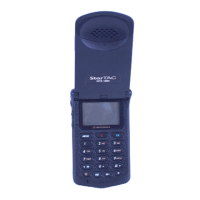DCS 1800 starTAC CELLULAR TELEPHONE
68P09304A85-O JMCK10
56 19/07/97
2. INSTALLATION PLANNING
2.1 COMPONENT LOCATION
While deciding where to install the StarTAC car kit
accessory components, the following general factors should
be observed:-
• The mounting surface must have sufficient strength to
support the component.
• The proposed location must not interfere with the
passenger seating or leg space.
• The portable telephone must be within easy access of
the operator during normal vehicle operation.
• Refer to section 2.7 of this section, regarding possible
interference with anti-skid braking systems.
Further information on the installation of each component is
documented later in the following sections.
2.2 ELECTRICAL SYSTEM POLARITY
The car kit is designed to operate in 12 volt negative earth
systems only. Use in other electrical systems may damage
the car kit, charger circuitry or portable telephone and void
any warranty.
IGNITION SENSE OPERATION
Portable Status Ignition Status Action Result
Portable Off Ignition On Depress PWR button Portable turns on
Portable Off Ignition On Turn off ignition Portable remains off
Portable Off Ignition Off Depress PWR button Portable turns on
Portable Off Ignition Off Turn on ignition Portable state same as when ignition was last turned off
Portable On Ignition On Depress PWR button Portable turns off
Portable On Ignition On Turn off ignition Portable turns off except if still in a call, or remains on in charge mode for set time if safety
timer enabled
Portable On Ignition Off Depress PWR button Portable switches to charge mode and times out
Portable On Ignition Off Turn on ignition Portable remains on
Table 1: Ignition Sense
CAUTION
No part of the StarTAC car kit should be attached to the
doors of the vehicle, or any other surface which may be
subjected to mechanical shocks.
2.3 USING FUSE LOOPS
Power to the MCK is taken direct from the vehicle’s 12V
supply. Two fuse loops (red and green) are used to connect
the regulator to the vehicle’s supply. A fuse loop consists of
a fuse holder with a large loop of wire connected to both
ends, which allows the loop to be cut in such a way as to
position the fuse holder in the most convenient/accessible
location.
The procedure is to position the fuse loops in approximately
their final location and determine the best location for each
fuse on the wire paths. Then cut the loop wire to locate the
fuses where required, ensuring that any excess wire is
disposed of correctly.
2.4 MINIMIZING ELECTRICAL NOISE
Many parts of a vehicle are capable of producing electrical
noise that may interfere with the telephone’s operation. The
ignition system is the most common source of electrical
noise interference, so the condition of the ignition wiring
and the connections to the battery should be checked. Verify
that low resistance connections exist between the battery
negative terminal, vehicle chassis and the engine block. All
wire connections should be clean and tight.
2.5 CONVENIENCE ON/OFF FEATURE
The convenience on/off feature allows the user to turn the
portable telephone on and off with the vehicle ignition key.
For correct operation of the equipment, the ignition sense
wire must be connected to an accessory A+ terminal on the
vehicle’s fuse block which is controlled by the ignition key
switch. Table 1. gives a more detailed operational
description of this feature.

